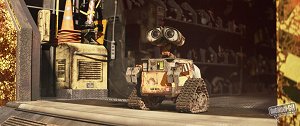 |
|
At The Picture Show
|
July 2008
Speechless
With minimal dialogue and a brilliantly rendered visual world,'WALL•E' is a staggering triumph

WALL•E
Walt Disney Pictures and Pixar Animation Studios
Director: Andrew Stanton
Screenplay: Andrew Stanton and Jim Reardon
Starring: The voices of Ben Burtt, Elissa Knight, Jeff Garlin, Sigourney Weaver,
John Ratzenberger and Kathy Najimy; and Fred Willard
Rated G / 1 hour, 43 minutes
Opened June 27, 2008



 (out of four)
(out of four)
WALL•E is a much-needed lesson in filmmaking. That it's a G-rated animated
movie is a mere detail. Whether they know it or not, this is the movie that everyone
has been trying to make - and, no doubt, will continue to try to make.
This is the light satire that Idiocracy had neither the wit nor intelligence to be. This
is the warm romance that Angel-A (and numerous other modern rom-coms)
couldn't dream of being. This is the robot-themed action movie that Transformers
wasn't, the post-apocalyptic character study that I Am Legend wasn't, the fully
realized futuristic landscape that few movies would take the time to explore.
 Countless movies have tried and failed to do what
WALL•E has done so effortlessly and unassumingly. This is the complete package
- a sci-fi fable-cum-romance-cum-1920s-style slapstick comedy - and it is a
masterpiece. A movie like this should cause other supposed blockbuster specialists
to stand up and take notice.
Countless movies have tried and failed to do what
WALL•E has done so effortlessly and unassumingly. This is the complete package
- a sci-fi fable-cum-romance-cum-1920s-style slapstick comedy - and it is a
masterpiece. A movie like this should cause other supposed blockbuster specialists
to stand up and take notice.
Thanks to director Andrew Stanton - with the help of the great cinematographer
Roger Deakins, one of the film's key visual consultants - WALL•E has a sense of
movement, composition and perspective that the Bays, Lucases, Emmerichs and
Verbinskis of the world too often neglect in favor of editing blurs and noisy visual
arrangements.
What such filmmakers seem to have lost is any sense of grace or restraint. Maybe
they have too much money to waste, too many toys to play with or too little
accountability from the teenage summer audience. Whatever the case, when it
comes to actually staging a scene, too often directors choose to just show us a
bunch of stuff they shot, instead of letting us experience it.
 Meanwhile, Pixar's finest are beating them at their
own game, bringing visual and action-oriented storytelling (action is way more
than gunfights, martial arts and big explosions) to a new level of artistry. From the
opening moments of WALL•E, a distinct vision comes across. We see a skyline of
compacted-garbage skyscrapers, a dusty-brown fog and a once-industrialized
wasteland of scrap metal and trash - all to the upbeat tune of "Put On Your Sunday
Clothes" from Hello, Dolly!
Meanwhile, Pixar's finest are beating them at their
own game, bringing visual and action-oriented storytelling (action is way more
than gunfights, martial arts and big explosions) to a new level of artistry. From the
opening moments of WALL•E, a distinct vision comes across. We see a skyline of
compacted-garbage skyscrapers, a dusty-brown fog and a once-industrialized
wasteland of scrap metal and trash - all to the upbeat tune of "Put On Your Sunday
Clothes" from Hello, Dolly!
We meet one character during this introductory passage, the titular robot WALL-E,
abandoned two centuries ago by the human race that created him. He collects old
remnants of the 20th and 21st centuries - gadgets, knick-knacks. He entertains
himself with old movies and new toys. But he's a garbage collector by trade, so he
goes about collecting garbage, picking it up, compacting it, stacking it. And when a
windstorm blows it all down, he goes and picks it right back up again. He's an
eccentric, computerized Sisyphus - who, after decades and decades of loneliness
and solitude, discovers that there is more out there than collecting old garbage.
That discovery comes in the form of EVE, a robot sent by the remaining humans -
who are now living fatly and lazily on spaceships, without a care in the world - to
search for evidence of vegetation on Earth so that humans can finally return to their
home planet. Once she finds what she's looking for, EVE - and, by happenstance,
WALL-E - get sent back to the mother ship, the Axiom.
 While the romantic attachment between the two
robots is an ongoing undercurrent, that relationship merely seems to get in the way
of the real problem - in an obvious nod to 2001, the ship's computer system has
taken over, refusing to allow humans to return to Earth. Needless to say, WALL-E,
EVE and the ship's enlightened captain have no choice but to save the day.
While the romantic attachment between the two
robots is an ongoing undercurrent, that relationship merely seems to get in the way
of the real problem - in an obvious nod to 2001, the ship's computer system has
taken over, refusing to allow humans to return to Earth. Needless to say, WALL-E,
EVE and the ship's enlightened captain have no choice but to save the day.
While there is plenty of human interaction and dialogue once we're on the axiom,
WALL•E is told largely through movement and color, drawing as much inspiration
from the physical comedy of Keaton and Chaplin as it does from the absurd
dystopian satire of Gilliam and others. What the film is able to accomplish visually
- entire sequences of plot progression - is astonishing in its creativity and wit. That
Stanton and his crew can draw so much personality from machines that have little
to no dialogue is an accomplishment in and of itself. That the film is so crisp in
telling a story more complex than it may seem, with only one prominent speaking
human character, is equally as impressive.
WALL•E takes swipes at American corpulence - both physical and financial - and
offers a refreshingly absurd take on familiar futuristic territory. The film was first
conceptualized more than a decade ago, and no matter how long it took to realize
it, the grand vision that's been gestating is apparent - and worth the wait. The
experience the film creates on all levels is an astounding accomplishment.
 In an age when some filmmakers are trying,
largely in vain, to create the illusion of reality with frustrating and inconsistent
motion-capture technology, and when summer blockbusters so often rely on
storytelling ticks that should have been outgrown in Year One of film school,
filmmakers like Andrew Stanton and Brad Bird (The Iron Giant, The Incredibles,
Ratatouille) have managed to create perfection through animation - and perhaps
have helped to change the notion of an Event Movie in the process. With WALL•E,
Pixar may have outdone itself.
In an age when some filmmakers are trying,
largely in vain, to create the illusion of reality with frustrating and inconsistent
motion-capture technology, and when summer blockbusters so often rely on
storytelling ticks that should have been outgrown in Year One of film school,
filmmakers like Andrew Stanton and Brad Bird (The Iron Giant, The Incredibles,
Ratatouille) have managed to create perfection through animation - and perhaps
have helped to change the notion of an Event Movie in the process. With WALL•E,
Pixar may have outdone itself.
Read more by Chris Bellamy